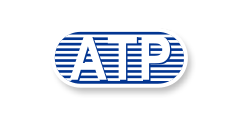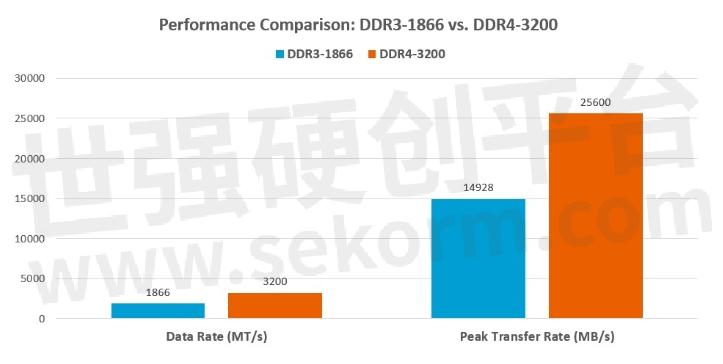DDR4 Differences and Advantages Over Previous Generation Modules

What is DDR4?
Double data rate fourth generation (DDR4) is a memory standard designed as a better, faster, more reliable replacement for DDR3.
How does DDR4 differ from DDR3 in appearance?
Physically, a DDR4 module, or dual in-line memory module (DIMM), looks very similar to a DDR3 DIMM. However, DDR4 has 288 pins compared with DDR3’s 240 pins; DDR4 SO-DIMMS have 260 pins instead of 204 in DDR3. The DDR4 key notch is in a different place, and the edge connector looks like a slightly curved “V” to facilitate insertion. This design also lowers insertion force, as not all pins are engaged at the same time during module insertion.
Figure 1. The pin count and key notch location for each DDR generation are different.
How does DDR4 differ from other DDR generations?
The following table compares the different DDR generations.
DDR Evolution

Table 1. Comparison of different DDR generations
What are the advantages of DDR4 over DDR3?
Lower power
DDR4 modules are more energy-efficient, operating only at 1.2V compared with DDR3’s 1.5V or 1.35V. The reduced power consumption gives substantial power savings and allows operation at higher speeds without higher power and cooling requirements.
Higher module density
DIMM densities start at 2 GB, reaching up to 128 GB – a big leap from DDR3’s 512 MB to 32 GB capacities.
Faster data transfer speed
ATP's latest DDR4 modules for embedded and industrial applications deliver high-speed data transfers up to 3200 MT/s. DDR4-3200, the latest industrial DDR4 offering from ATP, transfers data about 70% faster than DDR3-1866, one of the fastest DDR3 versions available, for a big boost in theoretical peak performance.

Table 2. DDR3-1866 vs. DDR4-3200

Figure 2. Performance comparison: DDR3-1866 vs. DDR4-3200.
Do the latest Intel® Xeon® Scalable processors support DDR4 modules from ATP?
Yes. Each of the latest Intel® Xeon® Scalable processors with Intel® C620 Series Chipsets (formerly code-named Skylake-SP and Lewisburg) provides native support for six memory channels that can operate at the same speed even at full load. Each memory channel supports two DIMMs, which means each processor can support up to 12 DIMMs. Having two additional memory channels compared with the previous quad-channel platform delivers a significant increase in speed and performance. Aside from Intel® Xeon® Scalable processors, DDR4-2666 is also built for 8th Gen Intel® Core™ Processors.
Which applications and industries will benefit most from DDR4-3200/2933/2666/2400?
The increased interface speed amplifies theoretical peak performance for the most critical computing applications in industries such as telecommunication infrastructures, networking storage systems, network-attached storage (NAS) servers, micro/cloud servers, and embedded systems like industrial PCs.
What DDR4 DIMM form factors are available from ATP Electronics?

Table 3. ATP DDR4 product family
How will I know if my system supports DDR4? Can I install a DDR4 DIMM on a DDR3 slot?
Every DDR generation is different from the others. DDR4 is not backward-compatible with DDR3 so a DDR4 DIMM will not fit on a DDR3 DIMM slot. Not only is the key notch of each DDR generation different (please refer to Figure 1 above), but the DDR4 pin size and arrangement is different from DDR3. Notice that towards the middle of the DDR4 module, some pins are longer, giving it a slightly curved "V" shape. Refer to your motherboard documentation to make sure that it has the correct DDR4 slot.

Figure 3. A standard DDR4 ECC DIMM module from ATP. Pins in the middle are longer, giving the module a slightly curved "V" shape.
How can I choose which DIMM type to use on my system?
Different DIMM types serve several purposes. DIMMs may or may not have error correcting code (ECC/non-ECC). They could be unbuffered or fully buffered (UDIMM/FB-DIMM), registered (RDIMM), or load-reduced (LR-DIMM). Different systems platforms can accommodate different memory types, so make sure to check which DIMMs are supported on your motherboard. For a quick look at common memory types, read "Understanding RAM and DRAM Computer Memory Types" on the ATP Blog.
Is it possible to combine DIMMs with different data rates on the same system?
To get the best memory performance, it is recommended that you install identical DIMMs on the same system. When mixing DIMMs of different operating speeds, the motherboard will underclock the faster one so it will only run at the speed of the slowest DIMM, unless you overclock the slow DIMMs. DIMM population guidelines may vary depending on the platform you are using. Refer to the server motherboard documentation for detailed instructions.
- +1 Like
- Add to Favorites
Recommend
- SMART‘s DDR4 Modules Range From 32GB To 4GB, 20% Lower Overall Power Vs. DDR3
- ATP‘s Fastest “Industrial Only” DDR4-3200 DRAM Modules with the Transfer speed of up to 3200MT/s
- DDR5 Fuels New Memory-Hungry Applications Latest Memory Standard Delivers 2X the Speed, 4X the Capacity, and Greater Power Efficiency Compared with DDR4
- DDR5 vs DDR4: Is DDR5 finally necessary?
- Alliance Memory 8Gb LPDDR4X SDRAM Offers 50% Reduction in Power Consumption Compared to LPDDR4 Devices
- ATP Wide-Temp DDR4 RDIMMs with I-Temp Registered Clock Driver Ensure Maximum Reliability in Extreme Temperatures
- DDR4-3200 DRAM Solutions Deliver Memory Boost to AMD EPYC™ and 2nd Gen Intel® Xeon® Scal | ATP
- ATP Rapid Diagnostic Test (RDT): Accelerating Failure to Maximize Reliability and Endurance
This document is provided by Sekorm Platform for VIP exclusive service. The copyright is owned by Sekorm. Without authorization, any medias, websites or individual are not allowed to reprint. When authorizing the reprint, the link of www.sekorm.com must be indicated.































































































































































































































































































































































































































































































































































































































































































































































































































































































